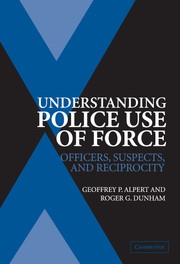Book contents
- Frontmatter
- Contents
- Acknowledgments
- Introduction: The Context of Police Use of Force
- 1 Police Use of Force: The History of Research
- 2 The Crucial Element: Finding Research Sites
- 3 Findings from Miami-Dade Police Department Study
- 4 The Sequential Steps in Use-of-Force Incidents in the Miami-Dade Police Department
- 5 Miami-Dade Police Department: Inconsistencies between Officer and Suspect Accounts of the Use of Force
- 6 Findings from Prince George's County Police Department
- 7 Findings and Summary
- 8 Explaining Police Use of Force: The Breakdown of an Authority Maintenance Ritual
- Appendix: Frequencies of Force Sequences for First through Tenth Actions
- Index
- References
2 - The Crucial Element: Finding Research Sites
Published online by Cambridge University Press: 14 July 2009
- Frontmatter
- Contents
- Acknowledgments
- Introduction: The Context of Police Use of Force
- 1 Police Use of Force: The History of Research
- 2 The Crucial Element: Finding Research Sites
- 3 Findings from Miami-Dade Police Department Study
- 4 The Sequential Steps in Use-of-Force Incidents in the Miami-Dade Police Department
- 5 Miami-Dade Police Department: Inconsistencies between Officer and Suspect Accounts of the Use of Force
- 6 Findings from Prince George's County Police Department
- 7 Findings and Summary
- 8 Explaining Police Use of Force: The Breakdown of an Authority Maintenance Ritual
- Appendix: Frequencies of Force Sequences for First through Tenth Actions
- Index
- References
Summary
researching a high-risk issue, such as police use of force, makes it difficult to find police departments willing to share their data and to cooperate in activities that help verify the accuracy and usefulness of that data. After carefully defining terms, choosing the best research method, and designing forms to capture all pertinent information, the researcher must also find cooperative research sites. The success of the earlier study (Alpert and Dunham 1997) highlighted both the difficulty and the necessity of finding cooperative agencies in order to produce meaningful research, albeit research that is limited to site-by-site findings. In this chapter we detail our contact with the various police departments we approached in connection with the various studies that led to the writing of this book. It is an account that demonstrates the many potential difficulties associated with this field, and again underscores the need for far more research into the use of force, research that would benefit from the sound conceptual framework we suggest in Chapter 8.
Miami-Dade Police Department
The Miami-Dade Police Department(MDPD) is located in Dade County, Florida. The agency is responsible for all law enforcement activities in the unincorporated areas of the county (it was formerly known as the Metro-Dade Police Department and the Dade County Sheriff's Department). In addition, MDPD also contracts with many of the municipal agencies within Dade County to perform specialized services. In 1998, the unincorporated areas of Dade County covered 1,840 square miles with a population of approximately 2,140,000.
- Type
- Chapter
- Information
- Understanding Police Use of ForceOfficers, Suspects, and Reciprocity, pp. 54 - 64Publisher: Cambridge University PressPrint publication year: 2004

